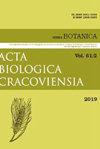Factors Affecting Doubled Haploid Plant Production Via Maize Technique in Bread Wheat
IF 0.5
4区 生物学
Q4 PLANT SCIENCES
引用次数: 11
Abstract
The effect of two in planta factors (growth conditions, genotype) and two in vitro factors (time of embryo rescue, embryo rescue medium) on doubled haploid (DH) plant production in bread wheat via maize technique was investigated in nine F 1 hybrids produced after crossing four bread wheat cultivars. During the first year one group of F 1 plants was grown in a field and at the proper stage pollinated with maize pollen (sweet corn popu- lation). In parallel, a second group of F 1 plants was grown in a growth chamber and pollinated as in the former group. In the second growing season the experiment was repeated but only field-grown plants were used. All the produced haploid embryos were cultured in three different media and the resulting 146 haploid plants were subsequently treated with aqueous solution of colchicine. Finally, 86 doubled haploid plants were obtained. We noted that the growing conditions of the parental plants and the intervening time between day of pollination and day of embryo rescue influenced the percentage of haploid embryo production. Culture medium also influenced haploid and doubled haploid plant production. The two media (MS/2, B5) were found equally effective. Most of the haploid embryos originated from the Penios × Acheloos cross, whereas most of the doubled haploid plants were produced from the KVZ × Penios cross. Doubled haploid plants were produced from all crosses. Culture, doubled haploid, embryos, haploid, maize technique, Triticum aestivum L.利用玉米技术生产面包小麦双单倍体植株的影响因素
以4个面包小麦品种杂交产生的9个f1杂种为材料,研究了植株内2个因素(生长条件、基因型)和离体2个因素(胚拯救时间、胚拯救培养基)对玉米技术生产面包小麦双单倍体(DH)植株的影响。在第一年,一组f1植株在田间种植,并在适当的时期用玉米花粉授粉(甜玉米种群)。与此同时,第二组f1植物在生长室中生长,并像前一组一样授粉。在第二个生长季节,重复实验,但只使用田间种植的植物。将得到的所有单倍体胚在三种不同的培养基中培养,然后用秋水仙碱水溶液处理146株单倍体植株。最终获得86株双倍单倍体植株。我们注意到,亲本植株的生长条件和授粉日与胚拯救日之间的间隔时间影响单倍体胚的产生率。培养基对单倍体和倍单倍体植株产量也有影响。两种培养基(MS/2, B5)的效果相同。大部分单倍体胚来自于Penios × Acheloos杂交,而大部分双倍单倍体胚来自于KVZ × Penios杂交。所有杂交均产生双倍单倍体植株。培养,双倍单倍体,胚,单倍体,玉米技术,小麦。
本文章由计算机程序翻译,如有差异,请以英文原文为准。
求助全文
约1分钟内获得全文
求助全文
来源期刊
CiteScore
3.00
自引率
0.00%
发文量
0
审稿时长
>12 weeks
期刊介绍:
ACTA BIOLOGICA CRACOVIENSIA Series Botanica is an English-language journal founded in 1958, devoted to plant anatomy and morphology, cytology, genetics, embryology, tissue culture, physiology, biochemistry, biosystematics, molecular phylogenetics and phylogeography, as well as phytochemistry. It is published twice a year.

 求助内容:
求助内容: 应助结果提醒方式:
应助结果提醒方式:


